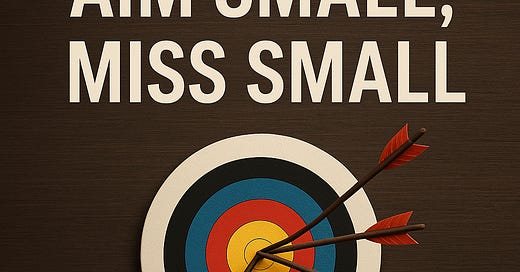"Aim small, miss small" is a phrase often used in marksmanship and sports. It means that by focusing on a small, specific target, your margin of error shrinks, if you miss, you still miss small. At its core, it’s a simple but powerful idea: the tighter you define your target, the more you minimize the consequences of a miss.
Think of it literally. A marksman aiming at a button-sized bullseye will likely land close to center, even on a miss. Someone aiming vaguely at the entire target board risks missing completely. A small miss at close range still counts as a good shot.
The same principle applies to how we approach goals in business, product design, leadership, really any meaningful pursuit. When we set vague ambitions like "win the market" or "build a great team," we leave ourselves exposed. What does success even look like? What exactly are we aiming for? It's like throwing a baseball into the fog and hoping you find the catcher.
But when we define a crisp, specific goal – win our first 1,000 true fans, ship a feature that cuts onboarding time by 30%, reduce checkout support tickets by half – we create a clear bullseye. We shrink the margin for disaster. Even if we miss slightly, we’re still close. It's the difference between hoping and executing.
Focusing small forces clarity. It demands precision. It turns ambition into something you can act on today, with measurable results tomorrow. And perhaps most importantly, it builds the habits of discipline and rigor that compound over time, the real drivers of sustainable excellence.
In a previous post, I mentioned that while I’m not naturally detail-oriented, I’ve worked on it for years because it matters deeply. Attention to detail isn’t about fussiness or micromanaging. It’s about caring. Small things like a spelling error, a missed follow-up, or a sloppy API contract aren’t isolated incidents. They’re signals. They reveal how someone thinks about their work, how they approach responsibility, and how much they respect the trust others place in them.
Attention to detail compounds. It shows up everywhere: in your products, your communication, your leadership. You don’t get to pick where you have high standards and where you don't.
A great real-world example comes from Pixar. In the book Creativity, Inc., Ed Catmull shares how, even when rendering backgrounds that appeared for only a few seconds, Pixar’s teams spent weeks perfecting lighting, shadows, and surface textures. In Finding Nemo, they engineered entirely new rendering techniques to realistically simulate how light filters through ocean water.
Most audience members wouldn't consciously notice those details. They wouldn't leave the theater saying, "The caustics were well simulated." But they felt it. The emotional connection worked because thousands of tiny details layered together into something seamless and unforgettable. Without that level of care, the illusion would have crumbled.
That's the real power of precision. It’s invisible, until it isn’t. It creates experiences that feel natural, products that feel inevitable, and relationships that feel trustworthy, all built quietly, through a million small, deliberate choices.
Another striking example comes from the early days of Amazon. In Working Backwards, Colin Bryar and Bill Carr describe how Jeff Bezos personally obsessed over tiny customer experience details, even when they didn’t seem scalable. One pivotal decision: Bezos insisted that after a customer placed an order, the confirmation page must show the exact estimated delivery date, not a vague "Ships in 2–3 business days."
It seems minor. It wasn’t. Setting a clear, accurate expectation reduced customer anxiety, cut down service calls, and built trust, long before Amazon Prime existed. That kind of detail wasn’t polish for polish’s sake. It reinforced Amazon’s brand promise: customer obsession, not competitor obsession.
If attention to detail is so powerful, why do so few individuals and teams deliver it consistently? Partly, it’s cognitive overload. In fast-paced environments, startups, scaling teams, even big companies, there’s constant pressure to move faster. Shipping becomes the goal, not meticulously solving customer problems. When velocity is celebrated more than craftsmanship, the small things start to slip. Ironically, skipping the small things often creates bigger problems later, slowing you down even more.
Culturally, many organizations reward visible progress: new launches, big announcements, quarterly goals hit. They rarely reward the quieter work of preventing future issues. Attention to detail rarely makes headlines, but it is often the backbone of durable success. Without a culture that values precision, even well-meaning individuals will lower their standards over time.
Finally, there’s simple human nature. It’s easier, and more immediately satisfying, to check off a task than to sweat the final 5%. Fighting the urge to call something “good enough” requires patience, discipline, and belief that small details matter even when no one is watching. It’s a long game, and long games are hard.
The good news: attention to detail isn’t a fixed trait. It’s a skill you can build, in yourself and in your teams, if you set up the right systems and incentives.
One of the most powerful tools is adopting checklists, as Atul Gawande highlights in The Checklist Manifesto. A simple surgical checklist dramatically reduced deaths in hospitals worldwide. It didn’t make doctors smarter. It made it easier for smart people to consistently execute small, critical steps under pressure.
In business or product work, lightweight tools can serve the same purpose. For example:
Create pre-launch quality gates requiring someone outside the project to review customer-facing details.
Use blameless postmortems to surface small misses before they become cultural habits.
Celebrate great craftsmanship just as much as speed, reinforcing the right behaviors.
Immersion techniques like the "Day in the Life" approach also make a difference. Spending real time with frontline employees or customers forces you to see the granular realities your decisions affect: the confusing error message, the extra click, the minor delay that quietly erodes trust. Details that are easy to overlook from a distance become obvious when you step inside the experience.
Not every decision requires painstaking attention. But for the decisions that are hard to reverse, precision isn’t optional. It’s mandatory.
This is where frameworks like the One-way Door vs. Two-way Door model help.
One-way doors are decisions that are difficult or costly to reverse, choosing a database technology, launching a major brand campaign. These demand careful attention because mistakes are expensive.
Two-way doors are reversible decisions, A/B testing a new homepage layout, experimenting with messaging. Speed matters more than perfection because you can easily course-correct.
Training yourself and your teams to instinctively ask, “Is this a one-way or two-way door?” before diving into a task can prevent wasted effort and build a culture of intentional precision. It helps teams aim small where it matters and move quickly where it doesn’t.
Ultimately, great organizations don't just care about details, they care about the right details. They develop a sense of proportion. They save their resources of time, energy, and focus for what truly moves the needle, while letting smaller decisions flow without endless debate.
Attention to detail is a force multiplier when aimed at the right targets. It’s not about doing everything perfectly. It’s about doing the important things exceptionally well.
"Aim small, miss small" isn’t just advice for marksmen. It’s a philosophy for building things that last. When you focus tightly on a customer’s real pain point, the true success metric, the tiny product detail that signals trust, you shrink the margin for error. Even when you miss, you’re close enough that recovery is fast, trust remains intact, and momentum builds.
Attention to detail isn’t about obsessing over everything equally. It’s about selective precision: knowing which doors are one-way, knowing which experiences customers will feel even if they can’t articulate them, and knowing that small habits compound into lasting excellence.
If you aim vaguely, you miss widely. If you aim precisely, even your misses teach you something useful.
This week, pick one area where you're tempted to settle for "good enough." Aim smaller. Get deliberate. Sweat the extra 5%. Excellence is not born from grand moments. It is built, quietly, through the small choices we make when nobody is watching. Aim small, miss small, and build something great.






>Think of it literally. A marksman aiming at a button-sized bullseye will likely land close to center, even on a miss. Someone aiming vaguely at the entire target board risks missing completely. A small miss at close range still counts as a good shot.
... ... ... who is this hypothetical marksman that had to be told, with a proverb, that his objective should be to aim for the center, i.e. the obvious place to aim for???